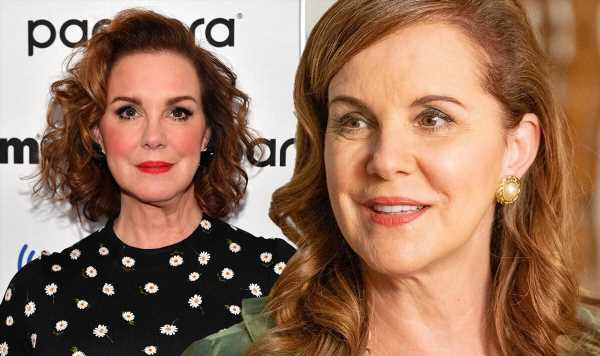Type 1 diabetes: Common symptoms and how it can be treated
We use your sign-up to provide content in ways you’ve consented to and to improve our understanding of you. This may include adverts from us and 3rd parties based on our understanding. You can unsubscribe at any time. More info
The 61-year-old, who has also appeared in films such as Big and lent her voice to Disney Pixar animation Finding Nemo has spoken out numerous times about the effect diabetes has on her life after being diagnosed back in 2005. As part of American National Diabetes Month, which usually falls in October, Perkins revealed that some of her first symptoms included fatigue, headaches and blurry vision. Convinced that she was suffering from an infection known as mononucleosis, or kissing disease, the star sought the help of her doctor, where she was shocked to find out she was actually diabetic.
“I was feeling fatigue, headache, blurry vision, excessive thirst and lost a lot of weight,” the New York native said back in 2015.
“I didn’t feel good, and the diagnosis just came through a routine blood test.” With her blood sugars firmly within the 600s, Taylor was defying the odds by only suffering symptoms. She added: “It’s amazing I hadn’t gone into a coma.
“It was such a shock when I was diagnosed, because I was fit and in the prime of my life. And in that first year, I felt very isolated and scared, and I was filming Weeds so I kept it a secret and would only test and inject my insulin when I was alone in my trailer.
“I was worried what the producers were going to think.”

Feeling lonely and affected by the certain stigma surrounding diabetes, Perkins began to blame herself, saying that she might have developed the condition due to eating too many burgers.
At one stage in 2018, Perkins spoke out again, revealing that in the past she had struggled to manage her condition after gaining 40Ibs – a side effect of having to inject herself with insulin four to six times a day.
“You’re injecting a hormone that stores fat,’ she explained.
“I just puffed up like a basketball. Everyone saw me get bigger and bigger. It’s been challenging as hell.”
Although everyone has insulin in their bodies, for those with type 1 diabetes, the pancreas – which makes insulin – is attacked by cells in the body, inhibiting its production. Due to the essential job that insulin plays in the body, it is important that we have it, which is why individuals suffer from various symptoms.
Unlike type 2 diabetes, type 1 has nothing to do with diet or lifestyle. In fact, researchers are unsure how the condition develops in the first place. Around eight percent of people in the UK who have diabetes, have type 1.
Learning to live with her condition, it wasn’t until Perkins began to share her experience that she was able to gain support of her friends, family and work colleagues. As part of this the star joined a US campaign with American company Sanofi U.S. to promote awareness about her condition.
Sharing how much the condition has impacted her life, Perkins said that cutting out sweets was not enough. She had to completely overhaul her lifestyle, which included eliminating starch from her diet.

Diabetes UK explains that individuals who are newly diagnosed with the condition should not worry about what they should or shouldn’t eat, especially if they use insulin pumps. Due to this, the same healthy and balanced diet that is recommended by medical bodies remains the same for diabetics.
Saying this, the website recommends that individuals try to include some carbohydrates in their meals, as without this, blood glucose levels may drop too low. Healthier recommended carbs include:
- Wholegrains
- Starchy foods
- Fruit and vegetables
- Unsweetened yoghurt and milk
- Nuts and seeds.
On the opposite end of the spectrum, foods and drinks high in sugar can increase blood glucose levels extremely quickly. This includes fruit juices. Instead, type 1 diabetics should aim to drink water, sugar-free and diet soft drinks.
As previously mentioned, type 1 diabetes can be relatively well managed in modern times due to the advancement of technologies such as insulin pens and pumps. These devices help individuals to inject themselves with insulin. Specifically, a pump is a battery-operated device that gives you insulin regularly throughout the day. It’s an alternative to injecting but it’s only available to people with type 1 diabetes.

Despite the advantages of devices such as this, Perkins warned others about “feeding the pump”, which refers to individuals gaining weight within the first few months of using the device.
The key, Perkins said, is to manage your diet and to use as little insulin as possible. She went on to reveal that if her blood sugar level gets too low, she relies on glucose pills to minimise her calorie intake.
As individuals get older, type 1 diabetes may need to be treated or monitored in slightly different ways. For example, an individual’s blood sugar target may change. However, with the help of a GP or medical professional individuals will be advised about any changes.
Giving advice for those newly diagnosed with type 1 diabetes, Perkins added: “My big message to encourage everyone with diabetes is that we have a whole community and you have to reach out and knock on that door. There are people waiting on the other side to support you!”
Source: Read Full Article



